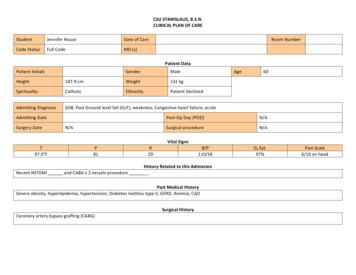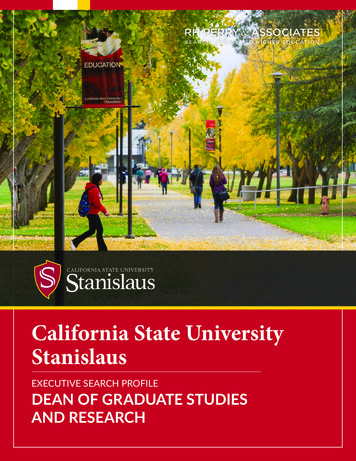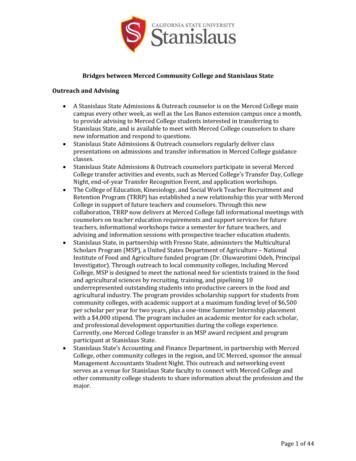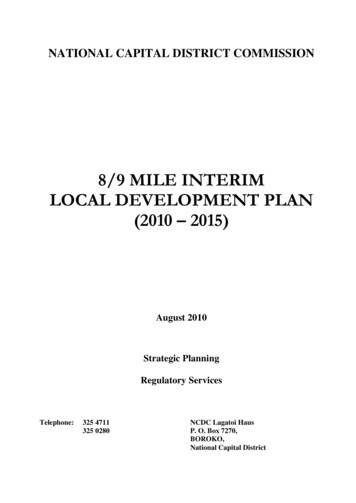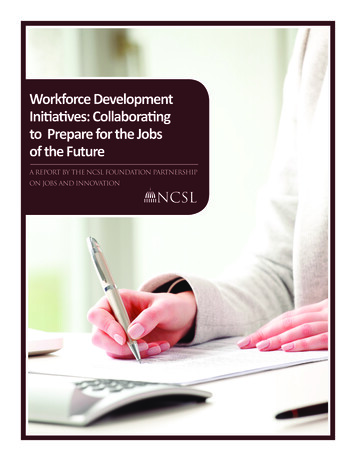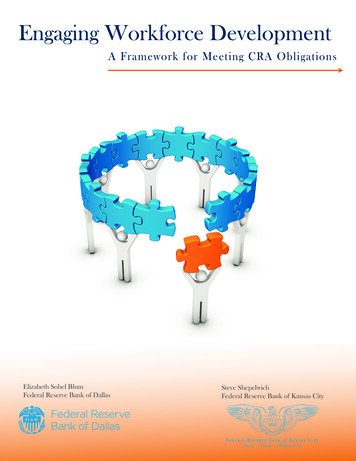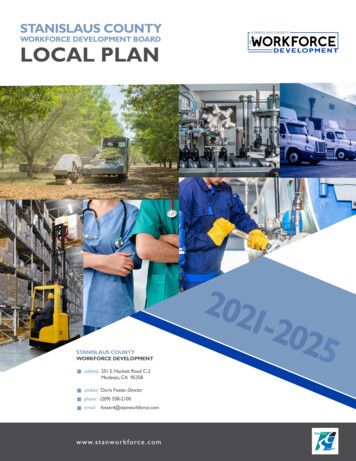
Transcription
STANISLAUS COUNTYWORKFORCE DEVELOPMENTaddress: 251 E. Hackett Road C-2Modesto, CA 95358contact: Doris Foster, Directorphone: (209) 558-2100email: fosterd@stanworkforce.comw ww.sta nwo rk fo rce . com
INTRODUCTIONThe Stanislaus County Workforce Development Board (SCWDB), as appointed by theStanislaus County Board of Supervisors (BOS) is the administrator of WorkforceInnovation and Opportunity Act (WIOA) funds and services in the local area. Acting asstaff to the Board and facilitating these services is Stanislaus County WorkforceDevelopment (SCWD). WIOA requires each Local Workforce Development Area (LWDA)to develop and submit a comprehensive four-year plan. This Local Plan term begins onJuly 1, 2021 and ends on June 30, 2025. Every two years the Plan must be re-evaluatedfor modification and adjustments based on changing needs for services and economicconditions in the local area. This is the second plan since the inception of WIOA.The primary purpose of the Local Plan is to facilitate access to workforce services at thelocal level. Stanislaus County Workforce Development staff has collaborated withAmerica’s Job Center of California Memorandum of Understanding partners, businesses,and community-based organizations throughout Stanislaus County. The publication of theLocal Plan for Stanislaus County is the result of months of local and regional research,formal and informal workgroup sessions, introspection, and process improvement. TheLocal Plan was cultivated by including the varying vantage points of multiple stakeholdersand current WIOA program participants.This Local Plan seeks to address current and future strategies and efficiencies that willcontinue the modernization of the workforce system. The Local Plan will change as localemployment needs and the relationship between workforce development and economicdevelopment continue to evolve, and circumstances that alter the ways services aredelivered to constituents of Stanislaus County materialize. The four-year Local Plan is theembodiment of SCWD’s vision and strategic goals and will be re-evaluated in two years.The goals set forth by the SCWD in this plan address the current workforce, prescribestrategies for the development of the future workforce, and call for a greater enhancementof business growth. Each goal is coupled with distinct strategies that SCWD believes willwork towards the fulfillment of the relevant goals. The Local Plans’ guiding principles ofcollaboration and alignment, data-driven strategy, and the maximization of resources arewoven throughout the fabric of this document.COVID-19 Impact on Stanislaus County and AJCC ServicesIn March of 2020, the State of California issued a general lockdown in response to theCOVID-19 global pandemic, which would go on for many months, affecting the coreeconomic drivers of Stanislaus County. Businesses not deemed essential were mandatedto cease normal functions and advised to close until further notice from the state. Thisclosure order adversely affected businesses and the workforce, driving theunemployment rate as recorded by Employment Development Department’s (EDD) LaborMarket Information Division, from 6.6% (February 2020) to a high of 17.5% (April 2020).As of December 2020, the Unemployment Rate was still high, remaining at 9.9%.Recovery for some businesses remained difficult, as restrictions from COVID-19 forcedintermittent closures in some industries.With the lockdown and subsequent residual effects of the pandemic, the manner in whichservices are delivered to the public were greatly affected. While many services did notstop, new and unique ways to meet the needs of the public had to be developed. For1
some industries, such as food services and entertainment, the pandemic resulted inpermanent closures of businesses. Other industries experienced a dramatic contractionof the workforce, with a subsequent gradual return to providing services to the public asthe pandemic receded, however, no economic sector was left untouched. Evaluation ofthis historic event will take years, and may entirely change common industry practices.The comprehensive America’s Job Center of California (AJCC) for Stanislaus Countyresides in a State Employment Development Department building. Due to the Governorsstay at home order, SCWD staff made the decision to close the Stanislaus CountyAmerica’s Job Center of California office, resulting in the cancellation of all in-personservices. While it is understood that not all services are as effective when providedelectronically, the safety of staff and the public was of primary concern to SCWD duringthis historical event.SCWD invested resources in the physical equipment that would allow for the continuanceof services through digital options. Computers with visual and audio capabilities, wereprovided to staff to prepare for the migration of services through electronic means.Additionally, multiple platforms for software to enable video conferencing were procuredto assure that staff and the public had interface options. Services such as Orientations,Resume Writing workshops, Work Readiness workshops, and individual one-on-onemeetings with clients needed new approaches, which would allow services to continue,while being cognizant of the need to protect the physical safety of both SCWD employeesand the public.As the comprehensive AJCC for Stanislaus County is located in the EDD building, astructured re-opening plan was necessary. In order to begin in-person meetings, SCWDstaff developed and submitted a re-opening plan to the State for approval. Upon approval,staff opened the AJCC for appointment only, in-person meetings.FEDERAL AND STATE REQUIREMENTS FOR LOCAL ADMINISTRATION OF THEWORKFORCE INNOVATION AND OPPORTUNITY ACTStanislaus County Workforce Development is primarily directed by WIOA, which wassigned into law by former President Barack Obama in July of 2014 and went into effecton January 1, 2015. References to the Workforce Innovation and Opportunity Act, PublicLaw 113-128, enacted July 22, 2014 are available at the U.S. Department of LaborEmployment and Training Administration website: www.doleta.gov.PUBLIC COMMENTIn accordance with WIOA, Section 108(d), the Workforce Development Board shall makecopies of the proposed Local Plan available to the public through electronic and othermeans, such as public hearings, Social Media sources, and local news media to allow forpublic comment. The Public Comment period will end no later than the end of the 30-dayperiod beginning on the date the proposed Plan is made available to the general public.Any comments that represent disagreement with the Plan will be included with submissionof the Local Plan. Appendix B of the Plan highlights the SCWD’s public commentsreceived.2
LOCAL OVERVIEWStanislaus County lies in the heart of the San Joaquin Valley of California, located in thecenter of the state. Stanislaus County, with nine incorporated cities and encompassing1,515 square miles, has a population of approximately 550,600 residents. The CountySeat is Modesto, the largest of the nine incorporated cities in Stanislaus County, whichalso includes Ceres, Hughson, Newman, Oakdale, Patterson, Riverbank, Turlock, andWaterford.Social Demographics SnapshotStanislaus County in many ways typifies the character of California as a whole. Whilethere are some dramatic demographic differences in the local area, as shown in Figure1, there are many similar characteristics between Stanislaus County residents andCalifornia residents as a whole. The most notable statistical differences in Figure 1 arethe households receiving food assistance, labor force participation rate for individuals witha disability and foreign-born residents.Figure 1. Stanislaus County Social DemographicsStanislaus 6.8%8.1%Speak English Less Than Very Well(population 5 yrs and over)Foreign BornWith a Disability, Age 18-64, LaborForce Participation Rate and SizeWith a Disability, Age 18-64UninsuredChildren in Single Parent Families(% of all children)Disconnected Youth (1)Enrolled in Grade 12 (% of totalpopulation)Households Receiving FoodStamps/SNAPPoverty Level (of all people)Source: JobsEQ-Economic Overview-Demographics1. Disconnected Youth are 16-19 year olds who are (1) not in school, (2) not high school graduates, and (3) either unemployedor not in the labor force.Although most Stanislaus County residents are classified as White, 45% of the overallpopulation identify as Hispanic. Asian ancestry is the next most populous ethnicity, with5.4% of county residents self-identifying as Asian. Interestingly, Figure 2 shows 10.2% ofresidents identify as “Some Other Race”, and 4.2% identify as two or more races, lendingcredence to the concept of multi-culturalism in Stanislaus County.3
Figure 2. Stanislaus County Race and 0.0%10.0%0.0%2.9%White0.8%Black or AmericanAfrican Indian andAmerican AlaskaNative5.4%Asian10.2%0.7%NativeHawaiianand OtherPacificIslanderSomeOtherRace4.2%Two orMoreRacesHispanicor Latino(of anyrace)Source: JobsEQ Demographic Profile Summary, ACS 5-Year Estimates 2014-2018Education SnapshotStanislaus County is home to two publicly funded post-secondary educational campuses.Modesto Junior College (MJC), part of the Yosemite Community College district is locatedin the heart of Modesto. MJC is primarily engaged in providing Associate Degrees andskills certifications, as well as providing preparation for students interested in transferringto a four-year college. MJC serves the needs of Stanislaus County residents in providingvocational education on a wide array of skills, teaching both theoretical and practicalapplications. MJC has partnered with SCWD on many occasions, providing WIOAenrolled individuals with pre-apprenticeship programs, cohort trainings, addressing adulteducation needs, and providing the community at large with educational options in a widearray of topics.California State University, Stanislaus is located in Turlock, and is the local provider ofpost-secondary education Undergraduate Degrees, Graduate Degrees, and AdvancedDegrees. Widely recognized for its dedicated faculty and high-quality academic programs,the University offers forty-three majors, forty-one minors and more than 100 areas ofconcentration, along with sixteen master's degree programs, seven credential programsand a doctorate in educational leadership.According to the Stanislaus County Office of Education Quick Facts report, the K-12Education System has twenty-five distinct school districts and one Office of Education,serving an estimated 110,400 students. There are nine Unified school districts, and oneHigh School district, servicing approximately 34,173 Secondary School enrollees (20182019 enrollments). SCWD has partnership relationships with the three largest schooldistricts, Ceres Unified School District, Modesto City Schools, Turlock Unified SchoolDistrict, as well as a cooperative agreement with The Stanislaus County Office ofEducation.4
The educational attainment of Stanislaus County residents is represented in Figure 3. Ofnote is the discrepancies between post graduate and graduate degrees held byStanislaus County residents as compared to the State of California as a whole.Figure 3. Educational Attainment, Age 25-645.2%Postgraduate Degree12.2%11.7%Bachelor's Degree21.6%7.9%7.9%Associate's DegreeSome College, No Degree21.5%High School Graduate20.4%No High School Diploma16.3%Stanislaus County25.7%29.2%20.2%CaliforniaSource: JobsEQ Demographic Profile Summary, ACS 5-Year Estimates 2014-2018.Workforce SnapshotStanislaus County’s workforce population has a reasonable distribution in terms of age,as shown in Figure 4. The segment of the population ages 25-59 account for 58.6% ofthe overall workforce, while youth workers age 16-24 represent the smallest percentageof working age individuals at 16.7% of the working age population. Workers in the 60 age ranges account for 24.7% of the working population, fully 8% higher than the youthworkers.Figure 4. Stanislaus County Working Age Population by Age Group70,38332,73916 to 19years37,51040,48520 to 2425 to 2963,57742,68438,28930 to 3433,29635 to 4445 to 5455 to 5930,91129,95460 to 6465 to 7475 yearsSource: ACS 1-Year Estimates 2019.5
The labor force participation rates and unemployment rates in Figure 5 paint a picturethat show the youth section of the labor spectrum is having difficulty entering theworkforce. Only 31% of youth from 16-19 participate in the labor force, and theunemployment rate is a staggering 19%. In contrast, 48% of 60-64 year olds are stillparticipating in the workforce, and have an unemployment rate of only 5%. 65 year oldshold a smaller participation rate, but the unemployment rate for this worker category isstill considerably lower than the youth rates. The lowest unemployment rates and highestlabor participation rates are predictably in the 30 to 59 year old categories, considered tobe the prime working age.Figure 5. Stanislaus County Labor Force Participation and Unemployment by Age Group83%80%78%70%80%71%48%31%19%16 to 19years13%20 to 2419%9%25 to 294%5%5%6%5%30 to 3435 to 4445 to 5455 to 5960 to 649%65 to 745% 8%75 yearsSource: ACS 1-Year Estimates 2019.Industry Sector SnapshotIndustries with existing demand in Stanislaus County are similar to those of the SanJoaquin Valley Regional Planning Unit (SJVRPU). Many factors are considered whendetermining the Industry Sectors which should be the focus of the Local WorkforceDevelopment Area. Factors may include growth, potential future emerging occupations,past and future commitments for development made by the County and its componentcities, make-up of current employment in the industry sector, and Location Quotient (LQ)which is a metric of the industry in Stanislaus County versus similar industries in othercounties (1.00 baseline). At the Stanislaus County Workforce Development Boardmeeting on January 4th, 2021, the Board re-affirmed the Industry sectors of Healthcare,Transportation and Warehousing, Agriculture, and Manufacturing as targets fordevelopment of industry sectors. Healthcare and Social Assistance is one of the largest employment sectors in thecounty and will likely continue that trend based on historical growth and the expandingneed for healthcare services. This need is being driven by demographics, an agingpopulation across the region, and a large expansion of access to healthcareinsurance beginning in 2014 with the Affordable Care Act. Health Care and SocialAssistance account for 18% of the total employment in Stanislaus County. Warehousing and Logistics, while encompassing a smaller share of the workforce(5%), has grown by 4.6% over the last five years and has a high concentration of6
workers compared to national trends. The growth in this sector is likely driven by theexpansion of online shopping in the past decade. Agriculture accounts for 8% of employment and Stanislaus County has five-times thenumber of workers compared to the national average (LQ 5.90). This is likely beingdriven by the San Joaquin Valley being one of the leading agricultural productionregions in the world. The low growth in agriculture can be attributed to automationand technological advances that reduce the number of workers needed as well asgeographic limitations on expansion of current agricultural output. Despite the lowgrowth, the seasonality of agriculture employment combined with outsized portion oftotal employment and LQ indicates that there is employment demand. Data from the Manufacturing industry suggests moderate demand for workers, witha growth rate of 0.0% locally over the past 5 years. While manufacturing does accountfor 11% of the jobs in Stanislaus County, these are largely in the agricultural foodprocessing subsectors. This tracks with a national contraction trend for employmentin manufacturing where the industry accounts for 8% all employment, but has seenonly 0.3% in annual job growth nationally over the past five years.Figure 6 below lists the industries with high to moderate employment demand. InStanislaus County, Transportation and Healthcare and Social Assistance are theindustries with highest percent employment, job growth, and concentration of sectoremployment (also referred to as location quotient or LQ).Figure 6. Stanislaus County Industries with Existing Employment Demands, 2020 Q2NAICS Industry% of TotalLocation 5-YearEmployment Quotient Annual(LQ)GrowthRate62Health Care and Social nsportation and Warehousing5%1.154.6%61Educational iculture, Forestry, Fishing and8%5.900.0%Hunting56Administrative and Support and Waste4%0.691.4%Management and RemediationServices92Public Administration3%0.551.5%72Accommodation and Food Services8%0.930.0%44Retail .4%0.6%1.1%Employment DemandHigh DemandHigh DemandHigh DemandHigh DemandModerate DemandModerate DemandModerate DemandModerate DemandModerate DemandModerate DemandModerate DemandModerate DemandSource: JobsEQ Industry Snapshot, 2020Q2 based upon a four-quarter moving average, ranked by Employment Demand.Proportion of total employment is calculated out of a total of 200,948 employed in Stanislaus County. Location Quotient is ameasurement of concentration in comparison to the nation. An LQ of 1.00 indicates a region has the same concentration of an7
industry (or occupation) as the nation. An LQ of 2.00 would mean the region has twice the expected employment compared tothe nation and an LQ of 0.50 would mean the region has half the expected employment in comparison to the nation.Occupational SnapshotAccording to statistics supplied by JobsEQ in Figure 7, the largest major occupation groupin Stanislaus County is Transportation and Material Moving Occupations, employing20,675 workers. The next-largest occupation groups in the County are Office andAdministrative Support Occupations (20,585 workers) and Sales and RelatedOccupations (18,858).Figure 7. Stanislaus County, Percent of Overall Occupational Employment by Industry, 2020 Q2LegalLife, Physical, and Social ScienceArchitecture and EngineeringArts, Design, Entertainment, Sports, and MediaComputer and MathematicalProtective ServiceCommunity and Social ServicePersonal Care and ServiceBuilding and Grounds Cleaning and MaintenanceBusiness and Financial OperationsInstallation, Maintenance, and RepairConstruction and ExtractionFarming, Fishing, and ForestryHealthcare SupportHealthcare Practitioners and TechnicalManagementProductionEducational Instruction and LibraryFood Preparation and Serving RelatedSales and RelatedOffice and Administrative SupportTransportation and Material 16,52218,85820,58520,675Source: JobsEQ Industry Snapshot, 2020Q2 based upon a four-quarter moving average, ranked by Percent of Total Employment.Proportion of total employment is calculated out of a total of 200,948 employed in Stanislaus County.Over the next year, the fastest growing occupation group in Stanislaus County is expectedto be Healthcare Support Occupations with a 2.7% year-over-year rate of growth. Thestrongest forecast by number of jobs over this period is expected for Healthcare SupportOccupations ( 311 jobs) and Food Preparation and Serving Related Occupations ( 179).Over the same period, the highest separation demand (occupation demand due toretirements and workers moving from one occupation to another) is expected in FoodPreparation and Serving Related Occupations (2,933 jobs) and Sales and RelatedOccupations (2,708).Occupational groups in Stanislaus County with the highest average wages per worker areas noted in Figure 8, Healthcare Practitioners and Technical Occupati
the University offers forty-three majors, forty-one minors and more than 100 areas of concentration, along with sixteen master's degree programs, seven credential programs and a doctorate in educational leadership. According to the Stanislaus

